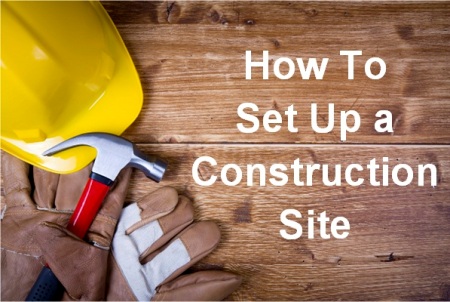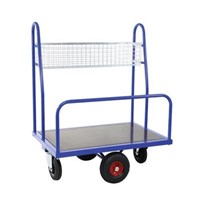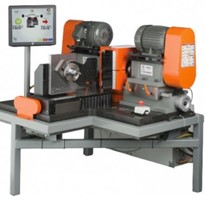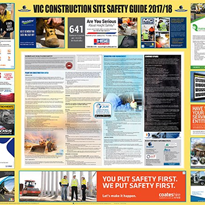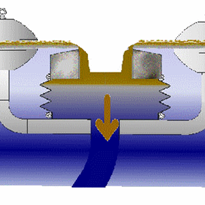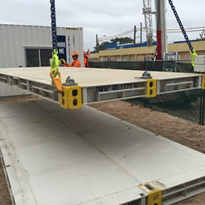This can often be overlooked or rushed through, however if the site is prepared correctly it can ensure construction runs smoothly and efficiently and that all workers and visitors are kept safe. Below is a 10-step guide to setting up a construction site complete with suggestions for the supplies you might need.
Assess the site and establish boundaries
Assess the construction site to locate any pre-existing utilities including water and electricity. Establish boundaries for the site taking into consideration the blueprints you have received from architects or engineers. Barrier mesh, steel posts and caps will help with fencing and barriers while spot marking spray will clearly indicate any utilities you have discovered.
Organise a phone line to be installed onsite
This may seem premature; however it will ensure the construction process continues efficiently as the site will be equipped to receive any updates to the plans and contracts via fax. Make sure the site office is stocked up with printer paper.
Erect a fence around the perimeter and utilise signs
After the site boundaries have been determined it is important to erect fences or boards as a physical barrier to the construction site. Ensuring the safety of site workers, visitors and passers-by should be a high priority. Signs should be put up on the external side of the fence detailing your company name and contact number, directions for site visitors and instructions on what sort of personal protective equipment (PPE) must be worn. On the internal side of the fence it is a good idea to have signs indicating any dangers and the location of first aid equipment.
Test the soil
Test the soil from a few different locations across the construction site. An environmental engineer will be able to advise if the site is contaminated or if you will encounter any problems with excavations or pouring concrete. Use silt fencing to prevent soil erosion or movement.
Identify hidden dangers
Conduct a search over the site to find any hidden dangers including old wells and shafts or any electrical cables, gas or water channels. It is vital to indicate these clearly while they are waiting to be covered over or filled in. This can be done in a number of ways including using spot marking spray, timber stakes with flagging tape or even hazard netting. Underground mains marking tape can be helpful here too with a number of different messages and detectable versions available.
Clear the site of any remaining vegetation or building structures
If there are any reusable materials that can be salvaged, store them out of the way onsite protected by steel posts and barrier mesh to clearly mark the obstacle.
Eradicate any rodents or insects from the site
Depending on the current situation you might need to hire a professional exterminator or may be able to just purchase your own supplies. This is an important step as pests can pose a health and safety risk but also be damaging to construction materials.
Organise site facilities
Organise facilities on site including a site office, storage areas, toilets, and a canteen or kitchen area. You will need to frequently restock supplies such as stationery, toilet paper, hand towels, hand cleansers and scrubs, coffee, tea, sugar, cups and stirrers to name a few.
Establish site security
This can be done in a number of different ways including alarms, security cameras, human or canine guards, locks and signs. The measures you take will depend on the needs of your site; however it is always better to overdo the security to prevent theft, damage and unauthorised entry.
Communicate site procedures and establishments
Inform management, workers, suppliers and potential site visitors of the steps you have taken to set up the site. It is important that each party has an understanding of the security, correct protocol and location of facilities onsite.
Other important things to consider during the set-up stage include providing the necessary PPE, safety equipment and first aid supplies adequately across your site.
- Suppliers
- New to IndustrySearch? Book a Demo
- Advertise with us
- Login
- Email Marketing
- Buyers
- Get Quotes
- Articles & Ideas
- Login
- Subscribe to newsletter
- My Details
- Get Quotes
- Automation & Control
- Automotive Workshop Equipment
- Commercial Cleaning Equipment & Supplies
- Construction Equipment & Heavy Machinery
- Conveyor Systems & Components
- Electrical & Power Generation Equipment
- Electronic Components
- Farming & Agriculture
- Food & Beverage Processing
- Forklifts & Forklift Attachments
- Hydraulic & Pneumatic Equipment
- Industrial Materials, Tools & Components
- Industrial Pumps
- IT Hardware & Industrial Computing
- IT Software & Applications
- Laboratory Equipment & Instruments
- Manufacturing & Industrial Equipment
- Material Handling & Lifting Equipment
- Metalworking & Machining
- Mining Equipment & Machinery
- Packaging & Labelling Machinery
- Pallet Handling Equipment
- Personal Protective Equipment
- Security & Surveillance
- Test & Measurement
- Transport & Logistic Equipment
- Warehouse Storage, Shelving & Racking
- Waste Treatment & Environmental Management
- Welding Machines & Accessories
- Woodworking & Joinery Machines
- Workplace Equipment
- Workplace Safety Equipment
- Get Quotes
- Automation & Control
- Automotive Workshop Equipment
- Commercial Cleaning Equipment & Supplies
- Construction Equipment & Heavy Machinery
- Conveyor Systems & Components
- Electrical & Power Generation Equipment
- Electronic Components
- Farming & Agriculture
- Food & Beverage Processing
- Forklifts & Forklift Attachments
- Hydraulic & Pneumatic Equipment
- Industrial Materials, Tools & Components
- Industrial Pumps
- IT Hardware & Industrial Computing
- IT Software & Applications
- Laboratory Equipment & Instruments
- Manufacturing & Industrial Equipment
- Material Handling & Lifting Equipment
- Metalworking & Machining
- Mining Equipment & Machinery
- Packaging & Labelling Machinery
- Pallet Handling Equipment
- Personal Protective Equipment
- Security & Surveillance
- Test & Measurement
- Transport & Logistic Equipment
- Warehouse Storage, Shelving & Racking
- Waste Treatment & Environmental Management
- Welding Machines & Accessories
- Woodworking & Joinery Machines
- Workplace Equipment
- Workplace Safety Equipment
Trusted by 1,000,000+ Australian industrial buyers
Buyers
- Discover products & solutions
- Login
- Subscribe To Newsletter
- Browse All Products
- Read Articles
Suppliers
Advertise
- Promote your products & solutions
- New to IndustrySearch? Book a Demo
- Login / Forgot Password
- Advertise Your Products
- Success Stories
- Email Marketing
- Suppliers
- Advertise with us
- Login
- Email Marketing
- Buyers
- Get Quotes
- Articles & Ideas
- Login
- Subscribe to newsletter
- My Details
Get Quotes
- Automation & Control
- Automotive Workshop Equipment
- Commercial Cleaning Equipment & Supplies
- Construction Equipment & Heavy Machinery
- Conveyor Systems & Components
- Electrical & Power Generation Equipment
- Electronic Components
- Farming & Agriculture
- Food & Beverage Processing
- Forklifts & Forklift Attachments
- Hydraulic & Pneumatic Equipment
- Industrial Materials, Tools & Components
- Industrial Pumps
- IT Hardware & Industrial Computing
- IT Software & Applications
- Laboratory Equipment & Instruments
- Manufacturing & Industrial Equipment
- Material Handling & Lifting Equipment
- Metalworking & Machining
- Mining Equipment & Machinery
- Packaging & Labelling Machinery
- Pallet Handling Equipment
- Personal Protective Equipment
- Security & Surveillance
- Test & Measurement
- Transport & Logistic Equipment
- Warehouse Storage, Shelving & Racking
- Waste Treatment & Environmental Management
- Welding Machines & Accessories
- Woodworking & Joinery Machines
- Workplace Equipment
- Workplace Safety Equipment
Get Quotes
- Automation & Control
- Automotive Workshop Equipment
- Commercial Cleaning Equipment & Supplies
- Construction Equipment & Heavy Machinery
- Conveyor Systems & Components
- Electrical & Power Generation Equipment
- Electronic Components
- Farming & Agriculture
- Food & Beverage Processing
- Forklifts & Forklift Attachments
- Hydraulic & Pneumatic Equipment
- Industrial Materials, Tools & Components
- Industrial Pumps
- IT Hardware & Industrial Computing
- IT Software & Applications
- Laboratory Equipment & Instruments
- Manufacturing & Industrial Equipment
- Material Handling & Lifting Equipment
- Metalworking & Machining
- Mining Equipment & Machinery
- Packaging & Labelling Machinery
- Pallet Handling Equipment
- Personal Protective Equipment
- Security & Surveillance
- Test & Measurement
- Transport & Logistic Equipment
- Warehouse Storage, Shelving & Racking
- Waste Treatment & Environmental Management
- Welding Machines & Accessories
- Woodworking & Joinery Machines
- Workplace Equipment
- Workplace Safety Equipment
Trusted by 1,000,000+ Australian industrial buyers


